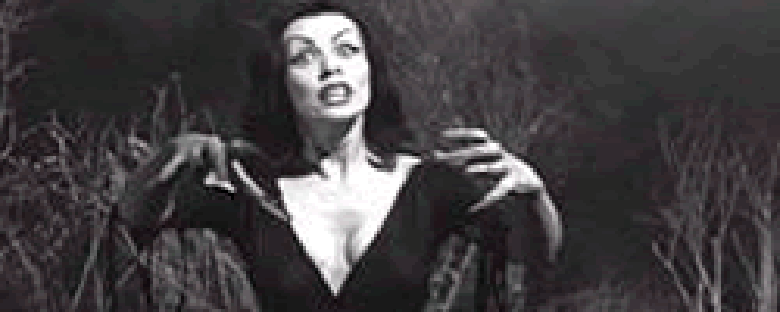Reviews
There is a scene near the end of Plan 9 From Outer Space in which flaming UFOs careen over an ominous graveyard. The scene is climactic in that it depicts the triumph of the human characters (who are intended to be sympathized with) over the alien grave robbers. This scene is met with heaving laughter by many viewers.
The title refers to the ploy of aliens to raid a San Fernando Valley graveyard, after eight failed attempts, and to resurrect an army of zombies. It takes a viewer with the most discriminating taste to wade through the schlock and appreciate a film like this.
Plan 9 From Outer Space is the creative apex of the disreputable Edward D. Wood Jr. The film is internationally recognized as the worst film ever made. Presumably, it was only measured against others in Wood’s filmography.
Plan 9 contradicts the very purpose of filmmaking to be engaging or altogether entertaining. The film is a dismal failure as actors’ deliveries are often stalled or stilted in some manner and the camerawork functions to capture images rather than to enhance them. Wood’s direction is virtually absent, as much of the film is comprised of generic stock footage.
Most science fiction films aim to employ a singular theme. Plan 9 instead opts to tackle every theme popular in Fifties film. Grave robbery, UFOs, monsters, and a mad scientist, Wood doesn’t merely employ clichés, he embraces them: no scientist can be too mad and no zombie too thirsty for human blood.
Despite the botched execution of the film, Wood’s ambition can be seen. It was clearly his attempt to meld elements of science fiction, horror, drama, suspense, and to a minor degree, politics. Plan 9 fails on every account. Curiously, watching his opus secede from any level of believability is a well spent eighty minutes.
This is a film so eminently watchable that every minute of it, every frame of celluloid is charged with humor. By this standard it is nowhere near the worst film ever made. That does not mean it is good.
Plan 9 is not a film you follow; it is one you merely observe in passing. Plot details are incidental as are characters. This is a rare case in which the efforts transcend the execution. The film is such a rambling mess of mischanneled ambition and lack of resources (a working flashlight appears to be the most valuable prop) that Wood’s proclaimed masterpiece elicits some sort of sympathy. The film’s humor is subtly underlined by quiet desperation.
Bela Lugosi was Wood’s prized actor. Lugosi is in three of Wood’s films and becomes the most laughable detail of Plan 9 as one of its primary villains, sort of. The beginning of the film includes a shot of Lugosi exiting his house and smelling some roses in his garden (symbolizing his appreciation for life). This is the only footage of Lugosi in the film, as the actor is rumored to have died before filming ended. The character (credited mysteriously as “Ghoul Man”) dies and becomes one of the first resurrected zombies by the aliens. In order to credit Lugosi, Wood cast a look-alike — his producer’s wife’s chiropractor. The chiropractor spends every minute of screen time with the lower half of his face hidden behind a cloak. In a manner reminiscent of the aliens in his film, Wood has goofily resurrected the dead.
Plan 9 From Outer Space is the greatest exercise of viewer tolerance. It is the one film that separates the callow from the urbane, rewarding those with sophisticated tastes and insulting those expecting something more legitimate. It is in result the greatest example of camp in the history of film. Nothing, simply, is this bad — or good, relative to what is expected. There is something to be said for a film that conjures humor unexpectedly. This is some sort of misperceived triumph on Wood’s part.
Wood’s most thematically engaging film is his semi-autobiographical Glen or Glenda? Only distantly fictional, the film traces the director’s struggle with transvestism. Glen or Glenda? contains Bela Lugosi’s most famous performance behind Dracula, in which he plays a raving madman of some sort. He sits in a leather chair, focused intensely on the camera lens, and furiously spouts words of nonsense. The mistaken comedy of Wood’s other films is lost in this scene. It is just disturbingly weird, and to the director’s benefit it can be assumed that this was his intent. Therein is his only known successfully directed scene.
The arc of Ed Wood’s later career spanned from softcore to hardcore pornography and from there combining pure smut. The title of his film Orgy of the Dead should be taken literally, and avoided. The director was also a soldier in World War II. Though not decorated, he claims to have worn a woman’s bra and panties in combat.
In the past decade Wood was the subject of a clever biopic directed by Tim Burton, entitled Ed Wood. The film owes as much to Wood’s history as it does to the humorous nature of his early filmography. It is by description a comedy. Ironic, then, that it is a completely realistic portrayal of the director. Or not.
Familiarity with Wood’s catalogue inspires a vision of the ill-famed director; it is one of him facing his actors with his megaphone unknowingly reversed. His words erupt in his face, fueling his conceit as his crew stands oblivious to his direction.
We don’t do comments anymore, but you may contact us here or find us on Twitter or Facebook.



